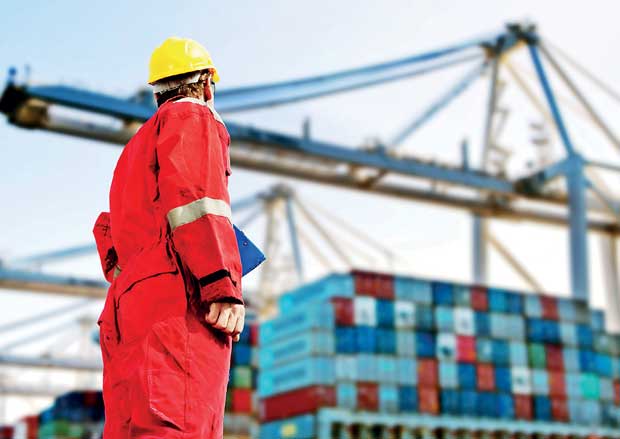Reply To:
Name - Reply Comment
Last Updated : 2024-04-18 06:32:00
 As per the World Trade Report 2015, implementation of the TFA could add up to 2.7 percent a year to world export growth amounting to US$750 to 1000 billion, and more than half a percent a year to world GDP growth
As per the World Trade Report 2015, implementation of the TFA could add up to 2.7 percent a year to world export growth amounting to US$750 to 1000 billion, and more than half a percent a year to world GDP growth
 The World Trade Organization (WTO), made their ultimate achievement at the 9th WTO Conference conducted in Bali, by finalizing the Trade Facilitation Agreement (TFA) in the year 2013 which came into effect 22 February 2017 with 2/3 of the members ratifying the agreement.It is paying more attention to customs procedures through effective cooperation between and other relevant authorities who become part and parcel of cross border activities.
The World Trade Organization (WTO), made their ultimate achievement at the 9th WTO Conference conducted in Bali, by finalizing the Trade Facilitation Agreement (TFA) in the year 2013 which came into effect 22 February 2017 with 2/3 of the members ratifying the agreement.It is paying more attention to customs procedures through effective cooperation between and other relevant authorities who become part and parcel of cross border activities.
Further, it caters to technical assistance and capacity building of leased developed countries and developing nations. Presently, 121 states have ratified the WTO agreement. In other words, these states have agreed to abide by conditions therein.
This agreement contains three sections and section one covers 12 different articles namely: publication and availability of information, opportunity to comment and consultation before information entry into force, advance rulings, procedures for appeal or review, enhance impartiality non-discrimination and transparency, fees and charges, clearance of goods, border agency cooperation, formalities connected with importation, exportation and transit, freedom of transit and customs cooperation.
Section two of the agreement covers, Special and Differential Treatment (SDT) provisions paving the path for preferential treatment for Least Developed Countries (LDCs) and developing countries. Section three containsprovision for formation of a permanent committee on trade facilitation at the WTO and membercountries establish national committees to facilitate domestic coordination and implementation of the agreement conditions.
What is trade facilitation?
Many definitions of trade facilitation can be found in recently done studies. Trade facilitation contains five essential features namely (as per study of ZAKI); simplification of trade procedures and documentation, harmonization of the trade practices and rules, transparent information and procedures of international flows, recourse to new technologies to promote international trade and more secured means of payment for international commerce. In another study done by Portugal Perez says, “Trade facilitation measures defined under two dimensions, tangible infrastructure such as roads, ports, highways, telecommunications etc. and intangible aspects such as transparency, customs management, the business environment.”
Asia Pacific Economic Cooperation (APEC) outlines trade facilitation as simplification and rationalization of customs and other administrative procedures that hinder, delay or increase the cost of moving goods across international borders. United Nations Conference on Trade and Development (UNCTAD) articulates it as a transparent and predictable environment for cross-border trade transactions based on simple, standardized customs procedures and practices, documentation requirements, cargo and transit operations, and trade and transport arrangements.
In simple terms, it can be recognized as, making it simpler and efficient for traders to move their goods across borders. Doing Business Index compiled by World Bank is also taking ‘Trading Across Borders’ as a significant evaluation criterion in ranking countries.
Under this category, time to export with regard to documentation and border compliance, cost of exports in compliance with documentation and border procedures, importation time and cost related to border procedures and documentation are taken for detailed evaluation. This confirms the importance of cross border trading at every level.
Cost reductions and increasing revenues through trade facilitation
It is a known fact in the world, that the Trade Facilitation is reducing the cost of trade by considerable level in any economy. OECD (Organization for Economic Cooperation and Development) has developed many indicators to this effect which help governments improve their border processors, decrease trade expenses and reach the best benefits through international trade.
TFIs (Trade Facilitation Indicators) provide paths to governments to lineup and prioritize activities related to trade facilitation in a more targeted manner. Some of these indicators can be listed asinformation availability, involvement of the trade community, advance rulings, appeal procedures, fees and charges, formalities related to documents and automation, internal cooperation, external cooperation and governance impartiality. It is vital for any economy to monitor the progress of their trade facilitation processes.
It is significant to understand that countries decide to implement WTO TFA in two ways; full implementation, which means taking the commitment to implement all the conditions in the agreement including best practices and the other method is to implement only the mandatory conditions of the agreement. The benefits reaped by any economy is also varied depending on the level of implementation of the agreement. In other words, some conditions will have a greater impact in reducing the cost of trade. To be more specific full implementation of the WTO Trade Facilitation Agreement will reduce the total costs of trade by 16.5 percent in low income countries and it will be 17.4 percent and 14.6 percent in lower middle income and upper middle-income countries respectively. In a situation where only mandatory provisions are implemented the total cost reduction will be around 12 to 13 percent only. (Source: WTO World Trade Report 2015)
Positive impact on exports
Further, TFA implementation will lead to increase of diversification of exported products in the range of 36 percent in Least Developed Countries (LCD) and approx. 20 percent in other developing countries andincrease of export destinations by 59 percent in LDCs and 33 percent in other developed countries. Further, as per the World Trade Report 2015, implementation of the TFA could add up to 2.7 percent a year to world export growth amounting to US$750 to 1000 billion, and more than half a percent a year to world GDP growth. (Source: WTO World Trade Report 2015)
Poor implementation leads to revenue losses
Inadequate border operations such as weak detection mechanisms and insufficient sanctions may lead to revenue losses. As a matter of fact, in Cambodia for example, only 25 percent of the goods are declared to customs showing greater loss of customs revenue.Due to complication of procedures it becomes monetarily rewarding to avoid customs.This may lead to various mal practices among the corrupt officials. All in all, studies have revealed that insufficient border procedures may lead to revenue losses equals to 5 percent of GDP.
Increase of government revenue
It is evident that implementation of TFA may lead to increase of government revenue in many ways. Namely, through the escalation of trade flows tax base and revenue collection may also increase. When the processes are simplified, the possibilities are high for traders to reduce informal activities and start paying duties, further, fraud detection in customs also will have a positive impact on revenues.
The case study on Bulgaria confirmed that, improvement of customs legislations and practices, training customs officials, improving customs controls resulted an increase of revenue by 158 percent. In the same manner, Ethiopia experienced over 51 percent increase of revenues whereas Peru made positive changes in their system by introducing best practices and system automation to reap over 105 percent revenue.
TFA benefits for SMEs
It is a known fact that, SMEs represent 90 percent of the global enterprises and provide over 70 percent of the employment of the private sector and recognized as growth and innovation engine. In developing countries, SMEs are playing a vital role in bridging the development gap through poverty reduction, women empowerment and income distribution.
They are facing many difficulties and challenges in accessing international markets. It is an internationally-accepted norm that policy level corrections are needed to ensure SMEs enter and continue to be in international trade. SMEs find it difficult to deal with regulatory processes associated with trading goods across borders. Recent studies have confirmed that reduction of complex border procedures will encourage SMEs to partake in more and more export/import activities.
With this background, WTO TFA gives a worthy policy outline for most of the countries including LDCs and developing nations, to address draw backs of SMEs. Many of the policies already in place in Asia Pacific and Europe, happens to be drafted with the existing importers and exporters in mind but not merely for SME community. Hence, SME’s contribution to the export revenue remains as low as 30 percent.
It is a known fact that in Sri Lanka, SMEs contribute more than 65 percent to the GDP of the country and increase of cross border efficiencies will bring many benefits for the SMEs such as their products getting diversified, reach many destinations faster than before. Even Multinational Corporations are making key decisions in relocating global value chain investments, following transport costs and capacity and customs efficiencies.
Importance of national trade facilitation committee
As per the WTO TFA, each member is expected to establish and maintaina national committee on trade facilitation in order to facilitate both domestic & international coordination and implementation of provisions of the Agreement. The role of this committee is much wider than documented, ensuring public and private sector dialoguethroughout the implementation process.
The National Trade Facilitation Committee (NTFC) is expected to follow a sequence of steps to comply with deliverables; define the mandate, identify a champion and ensure strong leadership, define the governance and legal structure, ensure the right balance between public and private stakeholders, establish clear terms of reference including the extent of the body’s independence, choose appropriate accommodation that reflects the body’s independence, establish a clear business or work plan of activities, ensure that the body is adequately and sustainably funded and monitor the progress of TFA implementation.
National trade facilitation efforts of Sri Lanka progressing
Sri Lankan government authorities have taken many positive steps towards implementing TFA conditions and requirements. A national need assessment was conducted in 2014 with the participation of government stakeholders inclusive of all the border agencies and private sector representatives.
The governmentof Sri Lanka has been effectively engaged in communication with WTO on the said aspects. By 2015 April, a team of experts from World Bank Group was engaged with Sri Lankan counterparts on Sri Lanka’s self-assessments and categorization aspects.
On 31 May 2016 Sri Lankan government ratified the WTO Trade Facilitation Agreement where it came to effect in February 2017. In April 2016, Cabinet nod was given to establish the National Trade Facilitation Committee which is chaired by Director General of Sri Lanka Customs and Director General of Department of Commerce as the co-chair, the government sector and the private sector is well represented in this committee ensuring well bonded Public Private Partnership, in achieving the ultimate goal of implementing TFA in Sri Lanka.
Taking the activities further, the World Bank Group, conducted another workshop for National Trade Facilitation Committee members, where category level tasks were assigned to border agencies on priority basis.
Additionally, Sri Lankan government requested, the support of World Bank Group for the development and implementation of web-based trade information portal, to develop the blueprint of the national single window operation, and to set up the Secretariat for National Trade Facilitation Committee under the leadership of Additional Director General Customs, and 2 consultants from the World Bank Group together with officers from Sri Lanka Customs and Department of Commerce.
The World Bank Group in principal has agreed to extend said assistance to Sri Lanka. Above activities confirm the right path that Sri Lanka is taking to Implement TFA successfully.
(The writer is the Secretary General / CEO of the National Chamber of Commerce of Sri Lanka)

Add comment
Comments will be edited (grammar, spelling and slang) and authorized at the discretion of Daily Mirror online. The website also has the right not to publish selected comments.
Reply To:
Name - Reply Comment
On March 26, a couple arriving from Thailand was arrested with 88 live animal
According to villagers from Naula-Moragolla out of 105 families 80 can afford
Is the situation in Sri Lanka so grim that locals harbour hope that they coul
A recent post on social media revealed that three purple-faced langurs near t

10 Apr 2024
09 Apr 2024